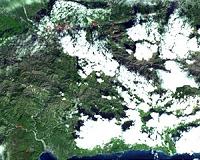 |
Greenbelt MD (SPX) Jan 20, 2010 Tropical Depression 01W formed in the Northwestern Pacific Ocean yesterday and is now headed for a landfall in Vietnam. NASA satellite data shows that the system is weakening as it continues on its track through the South China Sea. The Tropical Rainfall Measuring Mission (TRMM) satellite, managed by NASA and the Japanese Space Agency flew over Tropical Depression 01W (TD01W) on Monday, January 18 at 0859 UTC (3:59 a.m. ET/ 3:59 p.m. local time, Vietnam). TRMM noticed that the storm's rain fall was limited to the northern and western sectors of the storm. There were some isolated areas of heavy rainfall where rain was falling at about 2 inches per hour. However, most of the rain was moderate, falling at rates between 20 and 40 millimeters (.78 to 1.57 inches) per hour. TRMM images are pretty complicated to create. They're made at NASA's Goddard Space Flight Center in Greenbelt, Md. At Goddard, rain rates in the center of the swath (the satellite's orbit path over the storm) are created from the TRMM Precipitation Radar (PR) instrument. The TRMM PR is the only space borne radar of its kind. The rain rates in the outer portion of the storm are created from a different instrument on the satellite, called the TRMM Microwave Imager (TMI). The rain rates are then overlaid on infrared (IR) data from the TRMM Visible Infrared Scanner (VIRS). At 10 a.m. ET (10 p.m. Vietnam local time), January 19, Tropical Depression 01W had maximum sustained winds near 25 knots (28 mph). It was located about 190 miles southeast of Ho Chi Minh, Vietnam, near 9.1 North latitude and 108.7 East longitude. TD01W was moving northwest near 8 knots (9 mph). TD01W is generating 8- foot high waves in the South China Sea. Satellite data has also shown that TD01W's low level circulation center is exposed, and that the storm is in an area with vertical wind shear (which can weaken and tear a storm apart). An exposed center allows dry air or wind shear to enter the storm and weaken it. TD01W is forecast to weaken over the next 12 hours and dissipate after making landfall in Vietnam.
Share This Article With Planet Earth
Related Links TRMM Earth Observation News - Suppiliers, Technology and Application
 NASA's ASTER Instrument Observes Haiti Quake Aftermath
NASA's ASTER Instrument Observes Haiti Quake AftermathPasadena CA (SPX) Jan 19, 2010 On January 14, 2010, the Advanced Spaceborne Thermal Emission and Reflection Radiometer (ASTER) instrument on NASA's Terra spacecraft captured this simulated natural color image of the Port-au-Prince, Haiti, area, two days after a magnitude 7.0 earthquake struck the region and caused massive damage and loss of life. While ASTER's 15-meter (50-foot) resolution is not sufficient to see damag ... read more |
|
| The content herein, unless otherwise known to be public domain, are Copyright 1995-2009 - SpaceDaily. AFP and UPI Wire Stories are copyright Agence France-Presse and United Press International. ESA Portal Reports are copyright European Space Agency. All NASA sourced material is public domain. Additional copyrights may apply in whole or part to other bona fide parties. Advertising does not imply endorsement,agreement or approval of any opinions, statements or information provided by SpaceDaily on any Web page published or hosted by SpaceDaily. Privacy Statement |